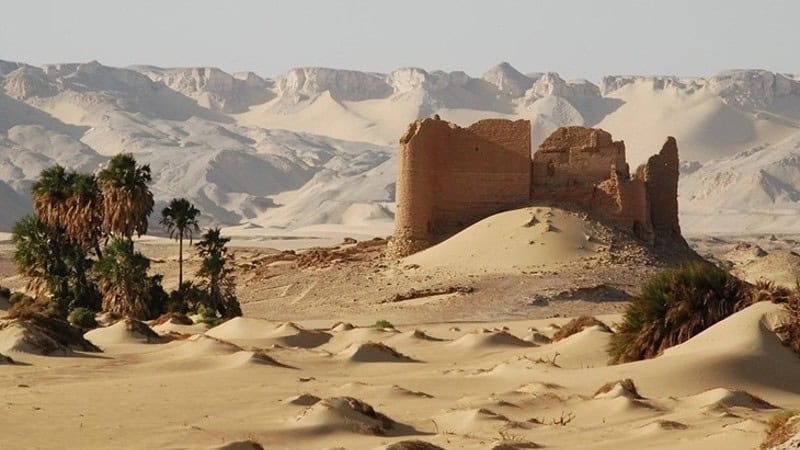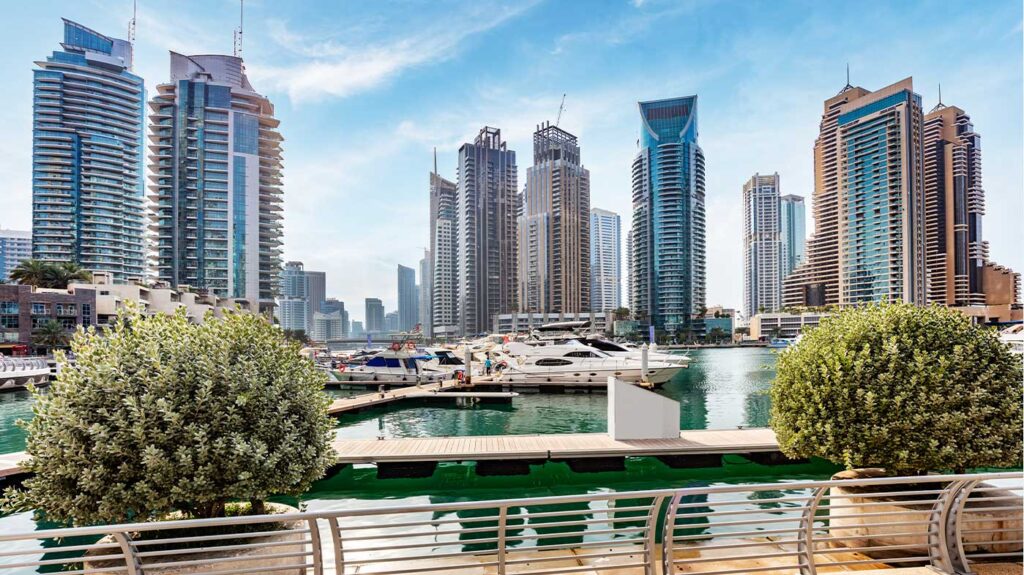Kharga Oasis, located in the Western Desert of Egypt, is the largest oasis in the region and boasts a rich history dating back to 7,000 BC. The oasis is known for its natural beauty, featuring palm groves, freshwater springs, and dunes that seem to stretch on forever. Despite being a peaceful escape from bustling cities, it is often overlooked by tourists.
Kharga, the oasis’s main town and transport hub, is entirely modern but has visitor facilities, and the district is dotted with ancient sites. The best sites are the Temple of Hibis and the cemetery of El Bagawat. The town is a great starting point for exploring the oasis and its surroundings, including the nearby Dakhla Oasis. With its rich history and natural beauty, Kharga Oasis is a hidden gem to explore.
History and Culture
Ancient Egypt and the Kharga Oasis
Kharga Oasis has a rich history of ancient times. The oasis was important in Ancient Egypt, serving as a transit point for desert caravans. The oasis was also an important source of food and water for the travelers. The Pharaohs inhabited the area, home to several temples dedicated to the god Amun. The Temple of Hibis, located in the Kharga Oasis, is one of the most significant ancient structures in the area. It was built during the 26th Dynasty and is considered one of the best-preserved temples in Egypt.
Religious Significance and Temples
The Kharga Oasis was a center of religious significance in Ancient Egypt. The Temple of Hibis is just one of the many temples built in the area. The Bagawat Necropolis is another significant religious site in the Kharga Oasis. It is home to several Christian cemeteries that date back to the 3rd century AD. The cemetery is also home to several ancient artifacts and cultural treasures.
Cultural Heritage and Archaeological Wonders
The Kharga Oasis is home to several archaeological wonders of great cultural significance. The Roman Fortress in the Kharga Oasis is an archaeological wonder. It was built during the Roman period and is considered one of the best-preserved fortresses in Egypt. The area is also home to several ancient artifacts and cultural treasures preserved over the centuries. The Kharga Oasis is a must-visit destination for anyone interested in ancient artifacts and cultural heritage.
The Kharga Oasis has great historical and cultural significance. It is home to several ancient artifacts and cultural treasures preserved over the centuries. Anyone interested in ancient Egypt, Hibis, Bagawat, the Temple of Hibis, the Necropolis, Christian cemeteries, the Roman Fortress, or any other archaeological marvel should visit this area.
Geography and Climate
The Western Desert and its Oases
Kharga is a city in the New Valley Governorate in Egypt and part of the Western Desert region. The Western Desert is a vast desert area that covers most of Egypt’s landmass. The region is characterized by its arid and hot desert landscapes dotted with oases. Kharga Oasis is one of the five oases in the Western Desert and is the southernmost.
Climate Patterns of Kharga
Kharga Oasis has a hot desert climate typical of the Western Desert region. The climate is characterized by clear skies, sunshine year-round, and extremely high temperatures. The mean yearly temperature observed in Kharga Oasis is 23.4 °C | 74.1 °F. During summer, temperatures can soar up to 42°C, while in winter, the average temperature ranges from 22°C.
Rainfall is almost non-existent in Kharga Oasis, with an almost complete absence of precipitation throughout the year. The Köppen and Geiger classification for the climate is BWh.
In conclusion, Kharga Oasis is a city in the Western Desert region of Egypt, characterized by its hot desert landscapes and unique oases. The climate is scorching and dry, with little to no yearly rainfall.
Tourist Attractions
Kharga has captivating tourist attractions, from historical sites to natural landmarks and educational museums. Here are some of the top tourist attractions in Kharga:
Historical Sites
Kharga is home to several ancient sites that glimpse the region’s rich history. The Temple of Hibis, located in the northern part of the city, is one of the most popular historical sites in Kharga. Visitors are impressed by this temple’s magnificent architectural designs, which date back to the 26th Dynasty.
Situated a short distance from the city center, the Necropolis of Al-Bagawat is another must-see historical site; it is an ancient cemetery that dates back to the 4th century AD and has some of the best-preserved tombs in Egypt.
Natural Landmarks
Kharga is located in the heart of the Western Desert, which means that stunning natural landmarks surround it. Take a Desert Safari tour to discover the vastness of the desert and witness the splendor of the Sahara.
One of the most popular natural landmarks in Kharga is the hot springs, just a few kilometers from the city center. These hot springs have healing properties, and many visitors relax and rejuvenate in the warm waters.
Museums and Educational Sites
For those interested in learning more about the history and culture of Kharga, there are several museums and educational sites to explore. Situated in the city center, the Kharga Museum showcases the rich history of the area through its collection of artifacts and exhibits.
Qasr Dush is Another educational site worth visiting, located just outside the city. The breathtaking architectural designs of this historic fortress, which was constructed during the Roman era, astonish guests.
Overall, Kharga is a city filled with fascinating tourist attractions that impress visitors of all ages. Kharga offers something for everyone, whether you are interested in visiting historical sites, scenic locales, or instructive museums.
Local Lifestyle
Cuisine and Crafts
Kharga’s local lifestyle is deeply rooted in traditional Egyptian culture. The town’s cuisine is a reflection of its history and geography. The fertile Baris region surrounding Kharga is known for producing some of the best dates in Egypt, and palm trees are abundant in the area. As a result, many of the local dishes incorporate dates, palm oil, and other palm products. Visitors can sample traditional Egyptian dishes at local restaurants and cafes, which offer a range of options, from simple street food to more elaborate dishes.
Besides its culinary traditions, Kharga is known for its pottery. The town has a long history of producing high-quality pottery sold in local markets and shops. Visitors can watch local artisans at work and purchase handmade pottery as souvenirs.
Daily Life and Economy
Kharga’s economy is based primarily on agriculture and hospitality. The town’s palm groves are a major source of income, providing both dates and palm oil. In addition, many locals work in the hospitality industry, running hotels, restaurants, and cafes.
Despite its small size, Kharga has a bustling daily life. Visitors can witness the town’s daily rhythms by walking through its streets and markets. The local economy is centered around a few main streets, where vendors sell everything from fresh produce to handmade crafts. The town also has a hospital and other essential services serving locals and visitors.
Overall, Kharga’s local lifestyle uniquely blends traditional Egyptian culture and modern amenities. Visitors can experience the town’s rich history and culture by sampling its cuisine, exploring its markets, and interacting with its friendly locals.
Travel Information
Getting There and Around
Kharga Oasis is located in Egypt’s Western Desert, approximately 550 km south of Cairo. The easiest way to get there is by air, with flights from Cairo International Airport to Kharga Airport. Daily buses run from Cairo to Kharga, with stops in Luxor and Asyut. The journey by bus takes approximately 12 hours.
Once you arrive in Kharga, the best way to get around is by taxi or car rental. Several car rental companies are in the town, and taxis are readily available. Exploring the oasis on foot or by bicycle is also possible, especially in the town center.
Accommodations and Amenities
Kharga Oasis has a range of accommodations to suit all budgets. Several hotels are located in the town center, as well as guesthouses and hostels. Most of the accommodations offer basic amenities, including air conditioning, hot water, and Wi-Fi.
Regarding amenities, Kharga has several banks, ATMs, and post offices in the town center. There are also several supermarkets and local markets where visitors can purchase groceries and souvenirs.
For those interested in exploring the surrounding areas, renting a 4×4 vehicle or joining a guided tour is possible. The Forty Days Road, a historic caravan route that connects Kharga with Dakhla, Sudan, and Libya, is a popular destination for adventure seekers. It is also possible to visit nearby attractions, such as the Temple of Hibis and El Bagawat Cemetery, within a short drive from the town center.
Frequently Asked Questions
What are the top attractions to visit in Kharga?
Kharga is a city that is rich in history and culture, and there are several attractions that visitors should not miss. Among the top attractions in Kharga are the ancient city of Al-Qasr, the Temple of Hibis, the Museum of Kharga, and the Kharga Oasis. These attractions offer visitors a glimpse into the city’s past and present and are sure to leave a lasting impression.
Where can one find traditional cuisine in Kharga?
Kharga is known for its delicious and unique cuisine, heavily influenced by the city’s history and culture. Visitors can find traditional cuisine at local restaurants, cafes, and street vendors throughout the city. Some of the most popular dishes in Kharga include koshari, ful medames, and taameya. These meals will fill you up and are prepared with tasty, fresh ingredients.
What is the best time of year to travel to Kharga?
The winter months of November through February are the ideal times to visit Kharga. This is the perfect time of year for outdoor activities and sightseeing because of the mild and pleasant weather. The summer months, from June to August, can be scorching and uncomfortable and are not recommended for travel.
Can you recommend some hotels or accommodations in Kharga?
Several hotels and accommodations in Kharga cater to various budgets and preferences. Some popular options include the Sol Y Mar Kharga Hotel, the Desert Lodge Hotel, and the Oasis Hotel. These hotels offer comfortable accommodations, excellent amenities, and easy access to the city’s top attractions.
How does one get around the city of Kharga?
The best way to get around Kharga is by taxi or by renting a car. Taxis are readily available throughout the city and are a convenient and affordable way to get around. Another smart move is to rent a car, which enables travelers to see the city on their own time and at their own speed.
Are there any cultural events or festivals in Kharga that visitors should know?
Kharga is home to several cultural events and festivals throughout the year, including the Kharga Date Festival, the International Festival for Oasis Heritage, and the Kharga Oasis Camel Race. These events provide visitors with an unforgettable understanding of the city’s history and culture, and they are not to be missed.
EGYPT MLS
Egypt MLS, under Arab MLS, is a cutting-edge real estate platform for licensed professionals, realtors, and brokers in Egypt. It offers a comprehensive property database for easy searching, comparing, and booking of properties for sale, set to revolutionize the real estate industry in Egypt.












